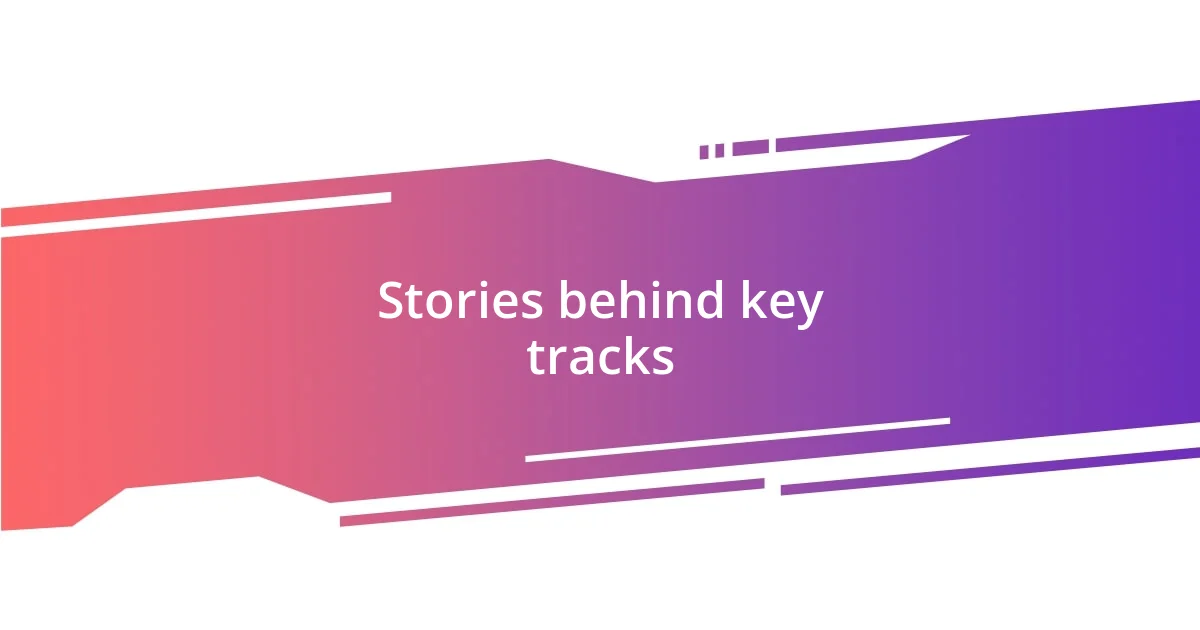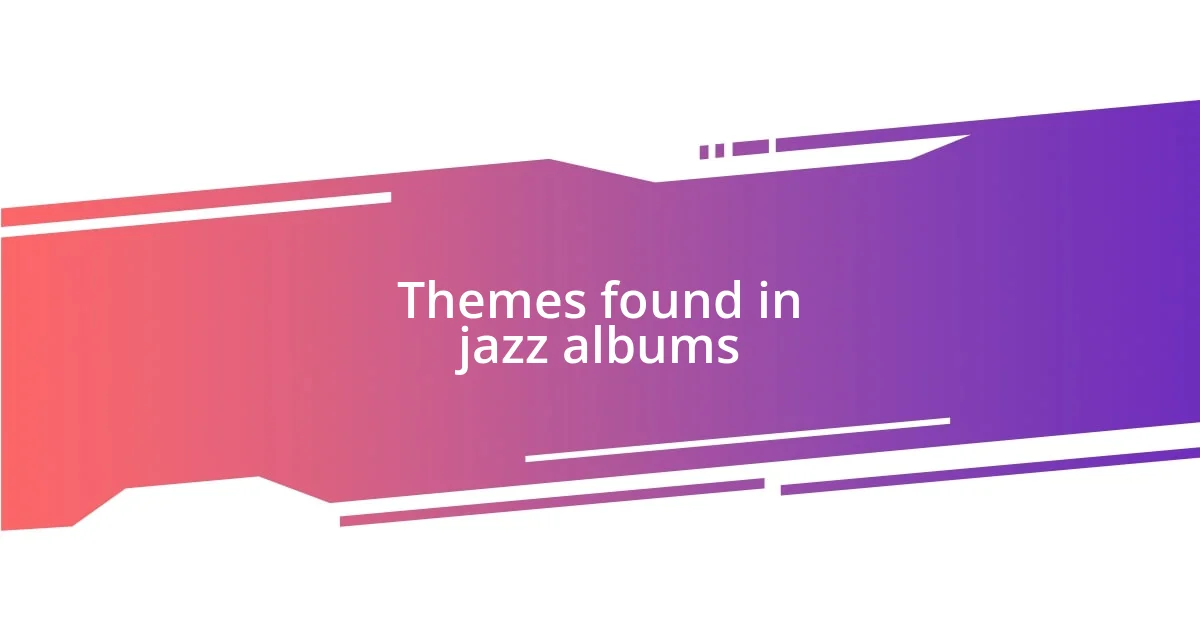Key takeaways:
- “Kind of Blue” by Miles Davis and “A Love Supreme” by John Coltrane evoke deep emotional connections and reflections on personal experiences.
- Jazz albums like “Mingus Ah Um” and “The Shape of Jazz to Come” serve as reflections of their era, showcasing social and political themes relevant to their time.
- Thematic exploration in jazz spans struggle and triumph, love, and social justice, highlighting the genre’s role in personal introspection and societal dialogue.

My favorite jazz album overview
One of my all-time favorite jazz albums has to be “Kind of Blue” by Miles Davis. The first time I listened to it, I was sitting in my living room, dimly lit with just the glow of a single lamp, and I remember feeling completely transported to another world. It’s fascinating how every note seems to tell a story—did you ever notice how the mood shifts with each track?
Another album that holds a special place in my heart is “A Love Supreme” by John Coltrane. I had a moment of pure epiphany the first time I heard it. As the opening notes washed over me, I felt an overwhelming sense of peace and connection. Isn’t it remarkable how jazz can evoke such deep emotions? I often find myself revisiting that album during times of reflection, feeling as if Coltrane himself is speaking directly to my soul.
Then there’s “Time Out” by Dave Brubeck, which always brings back memories of summer evenings spent with friends, laughing and reminiscing. The unique time signatures really took me by surprise when I first heard it—what a delightful twist! It’s an album that reminds me of the joy of exploring something new and unexpected, and the way it blends sophistication with accessibility is nothing short of genius. Have you ever listened to an album that completely changed your perspective on music?

Influential jazz albums to explore
What really strikes me about influential jazz albums is how they serve as a reflective mirror of their time. For instance, “Mingus Ah Um” by Charles Mingus encapsulates the social and political climate of the 1950s. The energy in tracks like “Fables of Faubus” truly captures a sense of urgency that resonates with the listener. I remember discussing this album with friends during a heated late-night debate about art and activism—talk about a lively conversation! Isn’t it inspiring how jazz can voice the struggles and stories of its era?
Another significant album is “The Shape of Jazz to Come” by Ornette Coleman. I was initially taken aback by its free-form structure, which challenged the traditional norms of jazz. It felt like stepping into an abstract painting; every listen reveals something new and unexpected. I recall the exhilaration I felt the first time I experienced “Lonely Woman.” That moment opened my eyes to the limitless possibilities of musical expression, sparking a curiosity that has fueled my love for jazz since.
Lastly, I can’t overlook “The Black Saint and the Sinner Lady” by Charles Mingus again, as its orchestral blend and intricate arrangements have profoundly shaped my understanding of jazz. The first time I listened to it during a thunderstorm, the rain outside perfectly matched the ebb and flow of the music. It’s incredible how one album can create such vivid memories. It’s not just an album; it’s an experience that transcends time and space.
| Album | Artist |
|---|---|
| Kind of Blue | Miles Davis |
| A Love Supreme | John Coltrane |
| Time Out | Dave Brubeck |
| Mingus Ah Um | Charles Mingus |
| The Shape of Jazz to Come | Ornette Coleman |
| The Black Saint and the Sinner Lady | Charles Mingus |

Iconic artists and their backgrounds
Jazz is often shaped by the lives and backgrounds of the artists who create it. For instance, the legendary Miles Davis came from a middle-class African American family in Illinois. His early exposure to classical music laid the foundation for his groundbreaking approach to jazz. I remember reading about how he faced numerous racial challenges, yet he transformed those experiences into music that resonated with many.
- Miles Davis: Pioneered modal jazz with “Kind of Blue”; his innovative spirit reflected his complex life.
- John Coltrane: Grew up in North Carolina; his spiritual journey during recovery from addiction deeply influenced “A Love Supreme.”
- Dave Brubeck: Born in California, his unique time signatures in “Time Out” mirrored his love for classical influences and experimentation.
- Charles Mingus: A New Yorker with a fascinating, turbulent life; his socially charged compositions were often personal statements on race and identity.
- Ornette Coleman: Raised in Fort Worth, Texas, Clemence’s journey into free jazz opened the door for new forms of expression, challenging conventions that I found liberating.
Each artist’s background not only enriched their musical style but also provided a lens through which listeners, like myself, can appreciate the depth of their work. The more I delve into their histories, the more impactful my experiences of their albums become.

Stories behind key tracks
When I think about “Take Five” from Dave Brubeck’s “Time Out,” I can’t help but recall the first time I heard that iconic piano riff. I was at a small café, and the moment it played, my entire perspective on time signatures shifted. The unusual 5/4 time was so refreshing, almost like a playful jolt that urged me to listen closely. Isn’t it fascinating how such a simple change can take you on a vibrant journey?
Then there’s John Coltrane’s “Acknowledgement,” the opener of “A Love Supreme.” This track resonates deeply with me because I often find myself contemplating my own spiritual journey in life. Every note seems to express a part of Coltrane’s search for higher meaning. I remember listening to it on a quiet Sunday morning, and how it felt like it wrapped around me, encouraging reflection. Isn’t it remarkable how music can guide us toward introspection?
Finally, I can’t overlook the emotional weight behind “Fables of Faubus” by Charles Mingus. The way Mingus employs his powerful bass lines to comment on social injustices struck me profoundly. The story behind this track, written in response to a governor’s refusal to integrate schools, makes the music feel like a call to action. I recall discussing this piece with a friend during a social justice workshop, and it sparked such an impassioned dialogue about art’s role in activism. Isn’t it incredible how a single track can ignite such powerful conversations?

Themes found in jazz albums
Jazz albums often encapsulate a myriad of themes that resonate deeply with listeners. For instance, the concept of struggle and triumph frequently emerges, evident in albums like Coltrane’s “A Love Supreme.” When I first listened to it, I was struck by how his journey through personal challenges mirrored the intensity of the music. It felt as if every note was a step toward overcoming adversity, inspiring me to reflect on my own experiences.
Another recurring theme is love, presented in all its forms—joy, heartache, and longing. An example that comes to mind is Bill Evans’ “Sunday at the Village Vanguard.” The tender, lyrical piano work evokes emotions that transport me back to moments I’ve shared with loved ones. There’s something magical about how Evans captures the nuances of a relationship with such beautiful, emotive tones. Have you ever felt so connected to a piece of music that it seems to tell your own love story?
Lastly, there’s the theme of social justice and cultural critique that many jazz musicians embrace. Take Mingus’ “The Black Saint and the Sinner Lady,” for instance. The chaos and complexity of his compositions reflect the tensions of society. I remember discussing this album with a group of friends during a debate on race and identity, and how it opened our eyes to the powerful role of music in telling truths. Isn’t it astounding how jazz can serve as both an art form and a platform for important conversations?















